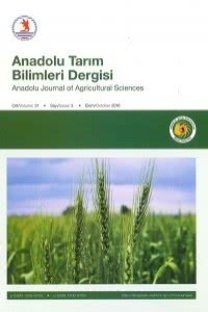Biçim zamanı ve kurutma methodunun kuru otun yem değeri üzerine etkisi
Bu çalışma, yonca ve kuru otunun yem değeri üzerine sabah ve akşam saatlerinde biçme ile sehpada ve 70 "C'de etüvde kurutmanın etkilerini belirlemek amacıyla yapılmıştır. Araştırmada yem materyali olarak yonca ve korunga otu kullanılmıştır. Otların yarısı sehpada diğer yarısı 70 "C'de etüvde 48 saat süre ile kurutulmuşlardır. Sabah ve akşam biçilmiş yaş yonca otu (YO) kuru madde (KM), organik maddeler (OM), ham protein (HP) ve ham selüloz (HS) içeriği sırasıyla % 92.72, 20.69 ve 21.94; % 92.37, 22.10 ve 20.39 olarak belirlenmiştir. Aynı şekilde sabah ve akşam biçilen yaş korunga otu (KO)'nun KM, OM, HP ve HS içerikleri sırasıyla % 92.17, 22.45, 24.60; % 91.18, 22.48 ve 24.97 olarak belirlenmiştir. Yine sabah ve akşam biçilen YO sehpada kurutulduğun da besin maddeleri içeriği aynı sırayla % 92.12, 22.43,25.28; % 92.14, 22.24 ve 25.60 olarak belirlenmiştir. Sabah ve akşam biçilen YO 70 ° C de kurutulduğunda organik maddeler, ham protein ve ham selüloz içeriği sırasıyla % 91.25,19.94, 22.43; % 91.41, 20.02 ve 21.63; KO için aynı değerler sırasıyla % 92.09, 22.05, 25.07; % 92.14,22.27 ve 25.18 olarak belirlenmiştir. Sabah ve akşam biçilen ve sehpada kurutulan KMS, OMS ve ME değerleri sırasıyla % 55.71, 53.15 1942.27 K cal/ kg; % 55.95, 53.24, 1969.39 K cal/ kg, KO için aynı değerler sırasıyla % 53.85, 51.89,1896.82 K cal/ kg; % 55.32, 52.55 ve 1920.46 K cal/ kg olarak belirlenmiştir. 70 "C'de kurutulan sabah ve akşam biçimi yonca otunun KMS, OMS ve ME değerleri sırasıyla % 55.87, 53.94, 1973.05 K cal/ kg; % 55.01, 53.96 ve 1981.33 K cal/ kg, KO için % 53.42, 50.24,1839.74 K cal/ kg; % 54.42, 52.65 ve 1930.92 K cal/ kg olarak belirlenmiştir. İklimin kurutmaya müsait olmadığı ve enerjinin ucuza mal çdildiği bölgelerde suni kurutma metodunun uygulanması ve kurutma işleminin zor olduğu bölgelerde gün sıcaklığından yararlanmak için otların sabah biçilmesi aksi taktirde akşam biçilmesi önerilebilir.
Anahtar Kelimeler:
yem değeri, yonca otu, kesme, kurutma, kuru ot, besin değeri, işleme, korunga kuru otu
Effects of cutting time and drying method on feed value of hay
This study was conducted to determine the effects of cutting time (moming and evening) and drying method (drying on schneder type tripod and drying at 70 °C) on the feed value of the hay.In this study, clover and sainfoin were used as feed material. Half of the hays were dried on tripod and the rest were dried at 70 °C. The nutrient contents of fresh clover material cut on morning and on evening were determined as 92.72, 20.69, 21.94 % and 92.37, 22.10, 20.39 % for dried matter, crude protein and crude fiber, respectively. The corresponding values for fresh sainfoin material were 92.17, 22.45, 24.60 % and 91.18,22.48 and 24.97 %, respectively. The nutrient contents of clover hay dried on table were found as 91.15, 19.80, 22.55 % (for morning-cutting) and 92.18, 20.58, 21.88 % (for evening-cutting), respectively. The corresponding values for sainfoin hay were 92.12, 22.43, 25.28 % (for morning-cutting) and 92.14, 22.24 and 25.60 % (for evening-cutting), respectively. While the nutrient contents of clover hay dried at 70 °C were found as 91.25, 19.94, 22.43 % (for morning-cutting) and 91.41, 20.02 and 21.63 % (for evening-cutting), these values were 92.09,22.05, 25.07 % (for morning-cutting) and 92.14,22.27 and 25.18 % (for evening-cutting), respectively. Dry matter digestibility (DMD), organic matter digestibility (OMD) and metabolizable energy (ME) values related to clover hay dried on tripod were found as 55.71 %, 53.15 % and 1942.27 K cal/ kg (for morning-cutting) and 55.95 %, 55.24 % and 1969.30 K cal/ kg (for evening-cutting), respectively. The corresponding values for sainfoin hay were 53.85 %, 51.89 % and 1896.82 K cat/ kg (for morning-cutting) and 54.32 %, 52.55 % and 1920.46 K cal/ kg (for evening-cutting), respectively. The DMD, OMD and ME values related to clover hay dried at 70 °C were found as 55.87 %, 53.94 % and 1973.05 K cal/ kg (for morning-cutting) and 55.01 %, 53.96 % and 1981.33 K cal/ kg (for evening-cutting), respectively. The corresponding values for sainfoin hay were 53.42 %, 50.24 % and 1836.74 K cal/ kg (for morning-cutting) and 54.42 %, 52.65 % and 1930.92 K cal/ kg (for evening-cutting), respectively. Artificial drying method can be advised for the regions in which the climate is not suitable for drying and for the regions in which energy is cheap. Besides, for the regions in which the drying process is hard morning cutting can be advised in order to make use of day-heat, otherwise evening-cutting can be advised.
Keywords:
feed value, clover hay, cutting, drying, hay, nutritive value, processing, sainfoin hay,
___
- ISSN: 1300-2988
- Yayın Aralığı: Yılda 3 Sayı
- Başlangıç: 2018
Sayıdaki Diğer Makaleler
İSMAİL SEZER, ORHAN KURT, Coşkun KÖYCÜ
Biçim zamanı ve kurutma methodunun kuru otun yem değeri üzerine etkisi
Allo ve autotetraploidlerde kromozom eşleşmesinin analizi
Sezgin UZUN, YUSUF DEMİR, Fikret ÖZKARAMAN, Bilal CEMEK
Değişik hammaddelerden boza üretimi ve üretilen bozaların bileşimi
M. Akif ÇAM, Erdogan SELÇUK, Mehmet KURAN, Mustafa OFLAZ
İbrahim MANGA, ZEKİ ACAR, İlknur AYAN, İSKENDER TİRYAKİ, M.Arif ÖZYAZICI
